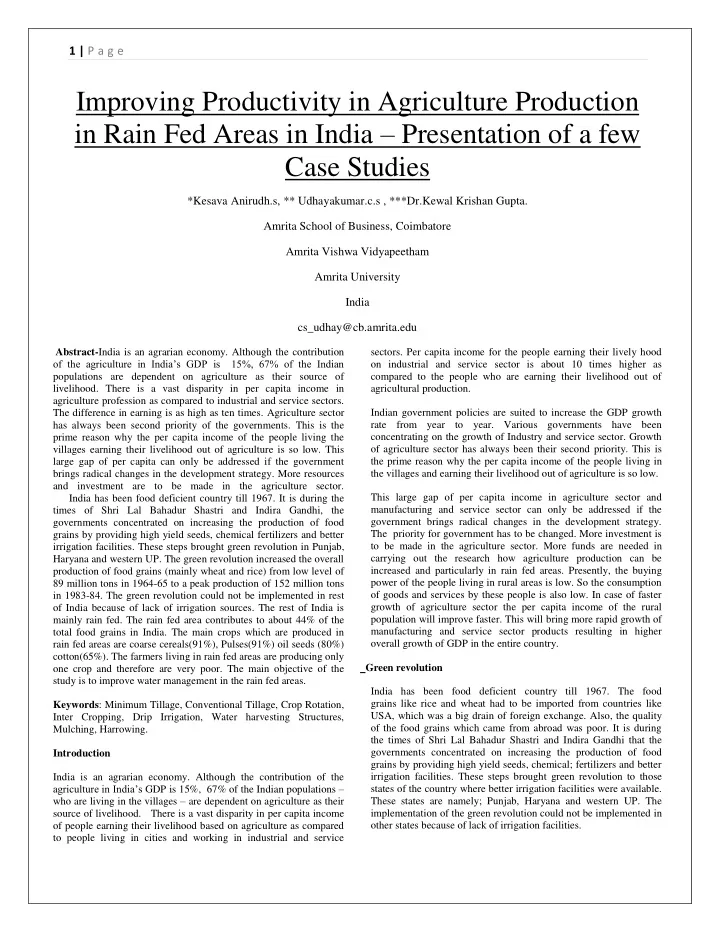

1 | P a g e Improving Productivity in Agriculture Production in Rain Fed Areas in India – Presentation of a few Case Studies *Kesava Anirudh.s, ** Udhayakumar.c.s , ***Dr.Kewal Krishan Gupta. Amrita School of Business, Coimbatore Amrita Vishwa Vidyapeetham Amrita University India cs_udhay@cb.amrita.edu Abstract- India is an agrarian economy. Although the contribution sectors. Per capita income for the people earning their lively hood of the agriculture in India’s GDP is 15%, 67% of the Indian on industrial and service sector is about 10 times higher as populations are dependent on agriculture as their source of compared to the people who are earning their livelihood out of livelihood. There is a vast disparity in per capita income in agricultural production. agriculture profession as compared to industrial and service sectors. The difference in earning is as high as ten times. Agriculture sector Indian government policies are suited to increase the GDP growth has always been second priority of the governments. This is the rate from year to year. Various governments have been concentrating on the growth of Industry and service sector. Growth prime reason why the per capita income of the people living the villages earning their livelihood out of agriculture is so low. This of agriculture sector has always been their second priority. This is large gap of per capita can only be addressed if the government the prime reason why the per capita income of the people living in the villages and earning their livelihood out of agriculture is so low. brings radical changes in the development strategy. More resources and investment are to be made in the agriculture sector. India has been food deficient country till 1967. It is during the This large gap of per capita income in agriculture sector and manufacturing and service sector can only be addressed if the times of Shri Lal Bahadur Shastri and Indira Gandhi, the governments concentrated on increasing the production of food government brings radical changes in the development strategy. The priority for government has to be changed. More investment is grains by providing high yield seeds, chemical fertilizers and better to be made in the agriculture sector. More funds are needed in irrigation facilities. These steps brought green revolution in Punjab, Haryana and western UP. The green revolution increased the overall carrying out the research how agriculture production can be increased and particularly in rain fed areas. Presently, the buying production of food grains (mainly wheat and rice) from low level of power of the people living in rural areas is low. So the consumption 89 million tons in 1964-65 to a peak production of 152 million tons in 1983-84. The green revolution could not be implemented in rest of goods and services by these people is also low. In case of faster growth of agriculture sector the per capita income of the rural of India because of lack of irrigation sources. The rest of India is population will improve faster. This will bring more rapid growth of mainly rain fed. The rain fed area contributes to about 44% of the total food grains in India. The main crops which are produced in manufacturing and service sector products resulting in higher overall growth of GDP in the entire country. rain fed areas are coarse cereals(91%), Pulses(91%) oil seeds (80%) cotton(65%). The farmers living in rain fed areas are producing only one crop and therefore are very poor. The main objective of the Green revolution study is to improve water management in the rain fed areas. India has been food deficient country till 1967. The food grains like rice and wheat had to be imported from countries like Keywords : Minimum Tillage, Conventional Tillage, Crop Rotation, USA, which was a big drain of foreign exchange. Also, the quality Inter Cropping, Drip Irrigation, Water harvesting Structures, of the food grains which came from abroad was poor. It is during Mulching, Harrowing. the times of Shri Lal Bahadur Shastri and Indira Gandhi that the Introduction governments concentrated on increasing the production of food grains by providing high yield seeds, chemical; fertilizers and better irrigation facilities. These steps brought green revolution to those India is an agrarian economy. Although the contribution of the agriculture in India’s GDP is 15%, 67% of the Indian populations – states of the country where better irrigation facilities were available. who are living in the villages – are dependent on agriculture as their These states are namely; Punjab, Haryana and western UP. The implementation of the green revolution could not be implemented in source of livelihood. There is a vast disparity in per capita income of people earning their livelihood based on agriculture as compared other states because of lack of irrigation facilities. to people living in cities and working in industrial and service
Recommend
More recommend